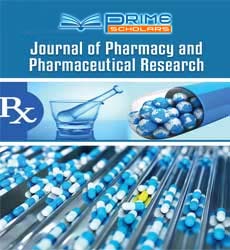Research Article - (2023) Volume 7, Issue 2
Medicines and Children: Parent Survey
Amal Naoui2,
Amine Cherif1*,
Asma Mhiri1,2,
Nesrine Kalboussia1,2 and
Balsam Kacema1,2
1Department of Pharmacy, Sahloul University Hospital, Sousse, Tunisia
2Department of Pharmacy, University of Monastir, Monastir, Tunisia
*Correspondence:
Amine Cherif, Department of Pharmacy, Sahloul University Hospital, Sousse,
Tunisia,
Email:
Received: 04-Mar-2023, Manuscript No. IPIPR-23-15838;
Editor assigned: 06-Mar-2023, Pre QC No. IPIPR-23-15838 (PQ);
Reviewed: 20-Mar-2023, QC No. IPIPR-23-15838;
Revised: 04-May-2023, Manuscript No. IPIPR-23-15838 (R);
Published:
11-May-2023, DOI: 10.21767/IPIPR.23.7.014
Abstract
Objectives: This survey was carried out to identify the problems encountered by parents when administering medicines and to consider ways to improve them.
Materials and methods: This study was conducted using questionnaires distributed to parents with children under 12 years old, via "Google Forms" software.
Results: Self-medication was a common practice in our sample. Syrups were the most commonly used and were considered to be the most suitable for the pediatric use. A significant portion of parents (78%) reported that they had been confronted with a refusal of treatment by their children. This refusal was mainly associated with the organoleptic characteristics of the medicines as well as difficulties related to administration. Besides, errors in the administration of medication, including dosing errors or forgetfulness, were mentioned by one third of respondents. To overcome acceptability problems, 68.11% of the parents used tricks to administer the medication to their children like co-administering it with food or drinks. Suggestions for improving the acceptability of drugs were mainly related to the palatability improvement, the reduction in the number of taken doses as well as the volume of liquid oral forms and the size of tablets or capsules.
Discussion: This survey showed that pediatric medicines did not necessary meet the needs of parents. Improvements could be made to raise acceptability and therefore ensure a better therapeutic adherence which is a key to the treatment efficacy.
Conclusion: This survey showed that pediatric drugs did not meet with parent’s needs. Improvements should be made in order to ensure acceptability and therapeutic adherence which is key to the treatment effectiveness.
Keywords
Dosage forms; Pediatrics; Survey; Parents; Medicine
Introduction
The study of medicines among pediatric patients has known a
great progress worldwide since 1997 in response to the new
legislation and regulations [1]. However, pediatric medicines
remain underdeveloped. The lack of adequate drug
formulations places health care professionals in an ethical
dilemma. Many medicines currently available for adults are
often used off-label in children [2]. The choice of a
pharmaceutical formulation adapted to the child is a real
challenge, both during drug development and clinical practice
since it influences the safety of the drug, its acceptability, its
administration and, consequently, its efficacy [3].
First, there are particularities in the physiological and
biological characteristics of the pediatric population, which
require a wide range of dosages. Second, the acceptability of
a drug by the pediatric patient differs from the other
population subgroups. Indeed, it is an essential aspect of drug
development and prescription. However, there is little
literature on the formulation factors that influences drug
acceptability, particularly in the ambulatory setting. Other
factors to be taken into consideration include the child's
ability to use a dosage form, the ease of administration for
both the child and the caregiver, the manipulations needed to
prepare the doses to be administered, the stability of the
dosage form, the special precautions, the type of pathology
(chronic or acute), and the cultural environment.
Nevertheless, the available dosage forms do not always seem
to be adequate for the use in children. Difficulties of
administration as well as refusal by children lead parents or
caregivers in general to mix medicines with drinks or food,
and sometimes to grind or crush dry oral forms. However, any
change in the dosage form can lead to dosing errors,
ineffective treatment or even exposing patients to adverse
effects. In this context, we chose to conduct a survey of
parents, who are the main stakeholders in the care given to
children.
Materials and Methods
This was a descriptive cross-sectional study. It was a survey
for parents with children under 12 years of age. The aim of
this work was to understand the drug habits of the pediatric
population, the problems encountered by the parents and to
consider ways to improve the different dosage forms.
Participants were required to anonymously complete a self-questionnaire
developed and published online via “Google
Forms” during the first semester of 2020.
The methodology for developing the set of questions was
based on a review of the literature.
The questionnaire consisted of 16 questions that had the
following objectives:
• To determine drug use patterns in the pediatric population
and risky practices.
• To analyze the acceptability of medications by children and
the problems encountered by parents with different types
of medications.
• To study parents' expectations and to consider ways to
improve the different dosage forms in order to promote
the proper use of medication.
The statistical analysis was performed by the SPSS software in
its 25th version with manual entry of the responses into a data
table which was recoded with nominal and ordinal variables.
A comparative study was based on the Chi-squared test, with
a significance threshold set at 5%.
Results
General Profile of the Survey Population
Our sample consisted of 323 parents with a female
predominance (84.83%). The average age of the parents
surveyed was 36, with extremes ranging from 23 to 57.
The majority of families in our panel (83.9%) had one or two
children under the age of 12. In total, we had 574 children
between the ages of 0 and 12, with an average of 1.78
children per family. Our pediatric population was almost
symmetrical. The sex ratio of the children was 1, 09.
Children aged 2 to 12 accounted for 79.21% (Figure 1).
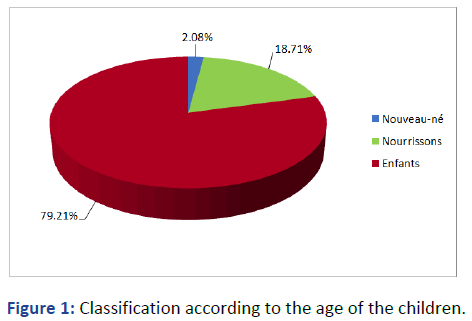
Figure 1: Classification according to the age of the children.
Habits of Drug Consumption
Self-medication: The drugs were consumed under medical
prescription in 95.36% of cases (n=308). Self-medication
was reported by 71.21% (n=230) of respondents, and
24.15% (n=78) reported giving a medication following
pharmacist's advice. Figure 2 illustrates the sources of
information for self-medication. The use of the same
prescription for two children was reported in 21.05% of
cases (n=68). In our sample, 10.53% of the children were
taking medication chronically. The rate of self-medication
was lower in this population (47.06%) (p=0.001).
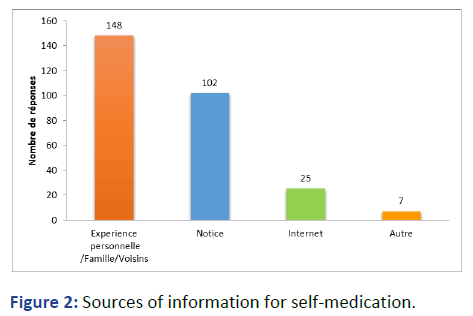
Figure 2: Sources of information for self-medication.
Preferred dosage forms: The most used dosage forms were
syrups (94.33%), creams or ointments (89.28%), vaccines
(86.67%), nasal forms (86.31%), oral forms for reconstitution
(85.44%), suppositories (73.38%), and powders (64.86%)
(Figure 3).
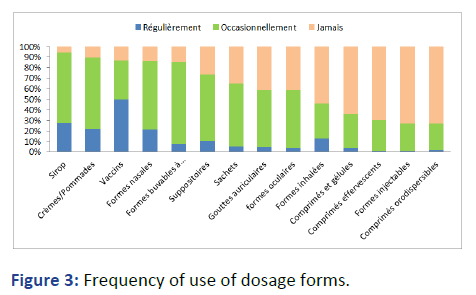
Figure 3: Frequency of use of dosage forms.
The Most Used Medicine Classes
We had 153 responses to this question. Almost 2/3 of the
surveyed parents (62.09%) mentioned a paracetamol based
drug as a syrup, suppository, or powders. The different classes
are detailed in Table 1.
| Drug class |
Number of answers |
|
Drugs of respiratory system
|
| Drugs used to treat asthma and chronic obstructive pulmonary disease |
38 |
| Drugs used to treat cough |
29 |
| Drugs used to treat rhinitis |
54 |
|
Anti-inflammatory, analgesic, and antipyretic drugs
|
| Analgesic and antipyretic drugs |
96 |
| Nonsteroidal anti-inflammatory drugs |
26 |
| Steroidal anti-inflammatory drugs |
3 |
|
Drugs of central nervous system
|
| Drugs used to treat epilepsy |
2 |
| H1 antagonists |
18 |
|
Anti-infective drugs
|
| Antibacterial drugs |
33 |
| Anthelmintic drugs |
2 |
|
Drugs of gastrointestinal tract
|
| Anti-diarrheal drugs |
3 |
| Drugs used to treat constipation |
2 |
|
Others
|
| Enzymes |
20 |
| Drugs for auricular use |
4 |
Table 1: Most commonly used medicine classes.
Acceptability and Compliance
In our sample, 86.07% of parents (n=278) reported that their children had refused to take medication. The problems
encountered by the parents are detailed by form (Table 2).
| Category of the problem |
Details of responses |
Number of answers |
|
Details of problems encountered with oral liquid forms
|
| Taste |
Bitter taste, strong taste, bad taste, overly sweet taste. |
95 |
| Smell |
Unpleasant odor. |
17 |
| Couleur |
Refusal due to dark color. |
1 |
| Administration |
Refusal to take, especially antibiotics, difficulty swallowing syrup. |
42 |
| Intolerance |
Vomiting |
2 |
| Texture |
Diarrhea |
2 |
| Non-homogeneous suspension, phase separation, difficult to dissolve, presence of granules, viscosity sticks to the bottom of the bottle. |
38 |
| Packaging |
Difficulty in opening some vials. |
2 |
| Delivery devices |
The pipette is inconvenient; hard the dosing devices of different drugs are mixed. |
6 |
| Administered volume |
The spoon is not practical, the content spills. |
2 |
| High volume to administer. |
3 |
| Conservation |
Shelf life after opening the vial is not clear. |
8 |
|
Details of problems encountered with powders
|
| Taste and smell |
Unpleasant taste and smell. |
7 |
| Administration |
No pipette for babies Inability to administer the full dose. |
2 |
|
Details of problems encountered with tablets and capsules
|
| Administration |
Refusal to take tablets and capsules Size, difficult to swallow. Or dispersible tablets are sometimes chewed or swallowed. |
17 |
|
Details of problems encountered with suppositories
|
| Administration |
Often rejected pain, irritation, local discomfort. |
14 |
| Conservation |
Melt with heat. |
1 |
|
Details of problems encountered with nasal forms
|
| Administrations |
Difficult to administer discomfort. |
9 |
|
Details of problems encountered with inhaled forms
|
| Administration |
Too long tube difficulty to inhale. |
3 |
Table 2: Difficulties encountered with different dosage forms.
In case of refusal, 11.46% of the parents (n=37) reported
stopping the treatment while the other 88.54% (n=286)
requested the doctor's advice for treatment substitution.
Appropriate Use of Medicines
Mistakes committed by parents: In our sample, 33.43% of
parents reported having made mistakes when administering
drugs to their children (n=108). Errors in the administered
dose were the most frequent (44.44%), followed by errors
related to omission and failure to comply with the frequency
of administration (35.18%). Table 3 details the errors as
described by the parents.
| Categories of errors |
Error details |
| Dose-related errors |
Use of the teaspoon instead of the pipette, therefore administration of a lower dose. Giving a higher dose than necessary. |
| Dose/weight: Ignorance of the exact weight of the child. |
| Giving a false dose in self-medication. |
| Both parents give the same medicine to the child (double dose). |
| Errors related to forgetting |
Non-compliance with administration schedules. |
| Failure to respect the duration of the treatment. |
| Errors related to administration |
Non-compliance with the salt free diet with corticosteroids. |
| Swallowing a sucking tablet (it was not mentioned on the box and the pharmacist did not specify it). |
| Administration position especially for nasal wash solutions. |
| Mix the drug with a large volume (bottle, water, yoghurt), in case of refusal to finish the whole volume, it is not known which dose has been administered. |
| Giving a powder without having dissolved it in water, choking. |
| Syrup spread on the skin instead of massage oil against bloating. |
| Confusing antipyretic and anti-inflammatory to be given alternately. |
| Giving iron and calcium based medications simultaneously. |
| Errors related to administration |
Forgetting to keep the medication in a refrigerator. |
Table 3: Mistakes committed by parents.
Tricks used by parents: We obtained 220 answers to
this question. The tips used are detailed in Figure 4. The administration of drugs with juice was mentioned in
43.18% of cases, followed by yogurt (26.36%).
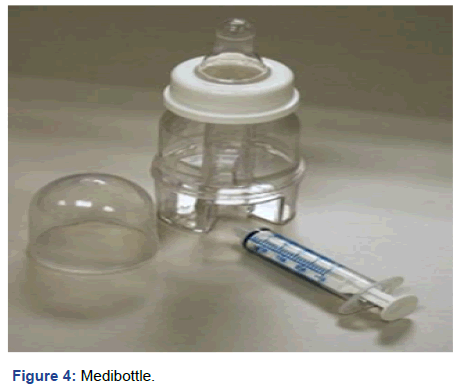
Figure 4: Medibottle.
Suggestions for improving the acceptability of drugs: We
received 252 responses to this question detailed in Table 4.
More than three quarters of the suggestions were related to
taste (78.57%). Odor was in second place with 17.46% and
then improvements in dosage form were cited in 15.48% of
responses. Packaging was mentioned by 9.92% of the parents.
Improvements in texture and color were cited in 4.36% and
3.57% of responses, respectively.
| Categories of answers |
Details of answers |
Number of answers |
Total of answers |
Percentage |
| Taste |
Improve the taste, less bitter taste, Children like sweet syrups Candy/fruity/strawberry/chocolate taste Diversify tastes (do not stay in the classic strawberry/banana) |
183 |
198 |
78.57% |
| Less sweet taste, no sugar added Subtle, neutral taste, the overly sweet taste is unpleasant. |
15 |
|
|
| Smell |
Improve the smell Aromatize the solutions, Add pleasant/natural aromas Odorless tablets |
44 |
44 |
17.46% |
| Texture |
Improve texture/ less concentrated/ viscosity |
8 |
11 |
4.37% |
| Easier to aspirate through the pipette |
1 |
|
|
| improve the solubility, less granules |
2 |
|
|
| Aspect |
Improve appearance, improve the color, no dark color |
9 |
9 |
3.57% |
| packaging |
Beautiful packaging, attractive, with their favorite heroes. Bottle in the form of animals/toys give a puzzle piece with each dose or give a toy with the drug |
25 |
25 |
9. 92% |
| Dosage form |
Develop the rectal route, develop suppository form for certain drugs that do not exist in this form (e.g. antitussives and corticosteroids). |
7 |
39 |
15.48% |
| Replace suppositories by other forms |
1 |
|
|
| Develop the tablet form |
1 |
|
|
| Drugs in the form of orodispersible granules |
3 |
|
|
| Replace the tablets with a syrup, avoid tablets (before the age of 7 years) |
4 |
|
|
| Decrease the dose to be administered, more concentrated solutions Improve the size/reduce the size of the tablets. Coated tablets with acceptable taste |
12 |
|
|
| Diversify the forms |
2 |
|
|
| Injectable forms for antibiotics |
1 |
|
|
| Develop drugs that can be safely mixed with juice or food |
1 |
|
|
| Develop drug in the form of candy, juice, chocolate |
6 |
|
|
| Make all medicines in cutaneous form, patches with drawings |
1 |
|
|
| Others |
Prefer graduated pipettes for the administration of syrups for children under 2 years of age. |
3 |
7 |
2.78% |
| Attractive delivery devices |
1 |
|
|
| Masks to facilitate the aspiration of liquids through the nose |
1 |
|
|
| To note recommendations to mothers in the leaflet |
2 |
|
|
Table 4: Suggestions for improving the acceptability of drugs.
Discussion
Habits of Drug Consumption
Self-medication: The number of medical prescriptions for
children seems to be high worldwide. In fact, more than half
of the children in the United States receive one or more
prescriptions each year [4]. In the United Kingdom, about 200
million prescriptions are dispensed each year to children and
young people [5]. In 95% of cases, parents used medicines
prescribed by a doctor for their children. Only 32% of the
cases mentioned the pharmacist's advice. Self-medication
was cited in 71.20% of the questionnaires. The sources of
information most frequently mentioned by parents were
personal experience/family/neighbors (45.82%) and then the
leaflet (31.58%). Parents whose children suffered from
chronic diseases seemed to be more reserved regarding self-medication.
The rate decreased from 72.20% to 47.05% for
these parents (p=0.001<0.05), so there is a correlation
between the type of pathology (chronic or acute) and the use
of self-medication. Although it is becoming more and more frequent, self-medication is not exempt from risks [6]. Self-diagnosis,
choice of medication, dosages and duration of
treatment may be inappropriate and carry the risk of
ineffectiveness and disease progression or, conversely, expose
the patient to overdose. In addition, there is the risk of
cumulating the same active ingredient present in different
drugs which seems to be ignored by most parents. There is
also the risk of drug interactions and undesirable effects that
could be serious, such as laxative syndrome and convulsions
under terpenes among infants. It is therefore necessary to
highlight the role of health care professionals, especially the
pharmacist who is the drug expert, in educating, alerting, and
orientating. Also, the pharmaceutical industry must support
this mission by organizing awareness actions around minor
pathologies, to encourage patients to go to pharmacies or to
their doctor's office to get the right advice. Some laboratories
have provided pharmacists with digital and interactive tools
to help them better advice and care for their patients.
Preferred dosage forms: Syrup was the most widely used
dosage form. In fact, the liquid oral forms are the most
suitable for pediatric use and they have always been the form
of choice for pharmaceutical companies seeking to develop
pediatric forms because they offer the advantage of dosing
flexibility [7]. Drugs for the cutaneous route were in second
place in frequency of use (89.28%). Nasal products were
widely used (86.31%). Suppositories were used by 3/4 of the
parents. The acceptability of the rectal route is culturally
dependent [8]. A study carried out in the Netherlands in 2000
[9] evaluated the frequency of drug use according to the age
group of children. About half (49.5%) of all prescriptions were
for oral medicines. The main changes with age were for oral
drugs: fewer prescriptions for oral solutions and more
prescriptions for tablets/capsules. The change in other
formulations was less important with age. Suppositories were
less prescribed to children aged over 5 years (a decrease of
7%-1%). The proportions of other formulations were roughly
constant, with about 10% of all prescriptions in all age groups
for ear, nose, and eye forms and 19% for creams and
ointments.
The most used medicine classes: Medications for pain and
inflammation were the most cited (79.74%). Paracetamol was
the most cited drug in 62.09% of cases and non-steroidal anti-inflammatory
drugs in 16.99% of cases. A survey conducted in
2005 showed that the drugs available at home to treat fever
in children were paracetamol in suppository form (71%) and
in oral form (62%) and ibuprofen as an oral pediatric
suspension (51%) [10]. Antibiotics were cited by 21.57% of
parents. A study in Italy [11] showed that in 2015 antibiotic
prescriptions were about 46% in the population of children
fewer than 13 years of age.
Acceptability and Compliance
Medication refusal was reported by 86.07% of parents in our
population. This result is higher than that obtained in a similar
study conducted in 2015 by Venables, et al., in England, which
showed that almost a third of the parents surveyed reported
having experienced medication refusal at least once and that
the age of the child was a significant factor predicting refusal,
with children aged 5 years to 11 years being the least likely to
have refused medication.
Liquid oral forms: Oral forms presented the largest barriers to
drug administration. The most frequently cited problems
were related to taste, smell, and texture. Palatability is the
most obvious and difficult challenge. It is defined as the
overall appreciation of a drug by organoleptic properties such
as the taste, aftertaste, flavor, odor, and texture of a drug to
be administered by mouth or swallowed. It is essential for
treatment compliance in the pediatric population and
influences the choice and design of the dosage form.
However, some generally acceptable medications are not
tolerated by all children because of taste and other
preferences. The concentration of medicines can also affect
their acceptability. Acceptability studies in children in France
showed that the preferred flavors are red fruits (strawberry,
raspberry, wild berries), followed by banana, candy, and
caramel. Flavors to avoid are mint and liquor ice [12,13]. The
problem of texture is most often encountered with
suspensions. A possible sedimentation is likely to generate an
underdoes or on the contrary an overdose; moreover, a bad
sensation in the mouth may occur [14,15]. Some parents
mentioned the frequency of administration as a difficulty.
Frequent dosing, i.e., more than twice a day, can have a
negative impact on adherence to the dosing regimen and may
conflict with the lifestyle of older children [16]. This problem
is often encountered with liquid oral forms because it is
difficult to obtain a prolonged release [17]. The volume to be
swallowed per dose was also a limiting factor. When the
volume of liquid exceeds a few milliliters, this can lead to
spitting or vomiting. Smaller volumes are better tolerated,
especially for preparations with known palatability problems,
unless dilution provides better taste masking. Oral solutions
containing paracetamol are an example of a problematic
liquid form. The volume of the dose often becomes too large,
even for infants [18].
Solid oral forms: Most of the answers concerned the dosage
form. The main disadvantage was the difficulty in swallowing
due to size. Indeed, the age at which most children acquire
the skills necessary to swallow tablets and capsules safely was
the subject of much debate. The early literature largely cites 6
years as the general age at which these dosage forms can be
considered suitable for children. Recent evidence suggests
that some children may have already acquired the ability to
swallow tablets and capsules at an earlier age or, in some
cases, may be trained through behavioral training
interventions [19]. For example, Yeung and Wong [20] found
that HIV-positive children as young as 3 years of age were
prescribed solid oral Staudinger.
Oral dispersible tablets are difficult for some children to
accept because of their texture and mouth sensation. A tablet
that disperses in the mouth always tastes and feels like a lump
remains in the mouth.
Inhaled forms: Problems related to delivery were reported
with the inhaled forms. Breath actuated devices as well as dry
powder inhalers require high breathing force and precise coordination and are therefore difficult to use for young
children. Aerosols also require hand lung synchronization.
Although therapeutic education is being implemented, the
difficulty of coordination limits the use of this form. However,
it is possible that the pharmacist may offer an inhalation
chamber to the parents to facilitate medication intake. Thus,
for all devices concerning the inhalation route, learning is
necessary since the risk of technical error is important.
Nasal forms: The nasal forms presented difficulties of
delivery. Even though most young children are uncooperative
during the administration of these forms, it is a relatively
short procedure as the volume of the drug is less than 2 ml-3
ml.
Rectal forms: Most of the problems were related to the child
himself, such as rejection of suppositories, refusal, and pain.
Problems of melting with heat were reported also. In fact,
rectal forms have several disadvantages, including decreased
absorption when the rectum is not empty; involuntary
expulsion of medication or during defecation; irritation
caused by certain excipients; storage problems (suppositories
melt at temperatures above 30°) and difficulties of
administration and acceptability for sociocultural reasons.
Appropriate Use of Medicines
Mistakes committed by parents: Medication Error (ME) was
defined in 2005 by the French society of clinical pharmacy as
a "deviation from what should have been done during the
patient's drug therapy management. It is the unintentional
omission or unintentional execution of an act relating to a
medicinal product, which may be the cause of a risk or an
adverse event for the patient". It can be committed by a
health care professional, a patient or a third party. In the case
of pediatrics, the third party may concern the parents or the
child's family and friends.
In our case, 33.43% of the parents had made a mistake when
administering medication to their children.
The most frequent errors were those related to the dose
administered (44.44%) and omission (35.18%). Other errors
were mentioned such as delivery positions, delivery
techniques or storage conditions. In view of the above, the
reduction in the frequency of administration and the single
dose formulation would reduce the risk of medication errors.
Another important source of dosing error is the increasing
diversity of available delivery devices.
Tricks used by parents: In our study, 68.11% of parents used
tips to improve drug acceptability by their children. A similar
study showed that nearly a third of the respondents reported
handling formulations. The majority of the manipulations
(79%) were done to make it easier to administer medicines.
Children often have difficulty swallowing both liquid forms
because of their unpleasant taste or smell, and solid forms
because of their large size making them difficult to swallow
whole. The medicine is often mixed with a suitable food or
drink to mask the unpleasant taste or smell and make it easier
to swallow. In our case, mixing medication with juice was
mentioned in 43.18% of cases, followed by yogurt (26.36%).
Our results were consistent with those of a survey of nurses in
the UK about the foods they used to administer medication to
children, with juice and yoghurt being the most frequently
used. Jams and milk were also commonly used. Although this
practice is common among parents, several concerns have
been raised about possible interactions between food and
drugs. Indeed, mixing certain drugs with juice can change the
pH, mixing with milk can induce binding to milk proteins and
the formation of insoluble complexes, and grinding of tablets
causes thermal degradation. Prolonging the contact time of a
drug with a foodstuff may increase the binding capacity and
thus reduce the bioavailability of the drug, which affects the
therapeutic effect. In addition, powders dispersed in a liquid
can be adsorbed on the walls of the container or sediment.
Therefore, the dose error is increased when only part of the
liquid is withdrawn and administered. In this context, FDA and
EMA guidelines stipulate that the volume of the vehicles used
should be small to ensure that the total dose of the drug is
delivered, while facilitating swallowing and allowing
acceptable taste masking. To guide parents in their choice of
vehicle, manufacturers must provide the necessary
information in the leaflet. The FDA has published a guidance
document on recommended approaches for the
determination of the appropriateness of vehicles for the co-administration
of pediatric drugs. Guidance is provided on the
selection of vehicles, description of standardized in vitro methods for assessing vehicle compatibility, and suggestions
on product labelling to communicate their acceptability.
Suggestions for improving the acceptability of drugs: To
ensure proper compliance, the discomfort experienced by
children or their parents when administering the medication
should be minimized. Children have a low tolerance for
unpleasant tastes, 78.57% of parents cited improvements in
taste. The use of tasteless or appetizing medications can
minimize the risk of spills and/or spitting. New excipients can
be sought to achieve this goal. It is important to note that the
overuse of sugars and sweeteners can put children at risk for
dental problems, obesity and type 2 diabetes. Electronic
tongues can also be used to detect the bitterness of solutions
before clinical trials set up. Their use would make it possible
to avoid the development of drugs with low palatability. Smell
was in second position (17.46%), improvements in dosage
form were mentioned in 15.48% of responses. Improvements
in texture and color were cited in 4.36% and 3.57% of
responses, respectively. The reduction of the volume to be
swallowed, the size of the tablets as well as the number of
intakes were suggested by 11 parents. In this context, the
development of sustained release drugs can be encouraged.
Indeed, this type of formulation limits the number of doses
taken and has a smaller impact on the patient's daily life.
Although these techniques were long reserved for solid forms,
a number of new approaches have been studied for the
development of sustained release liquids, including ion
exchange resins, coated micro particles in suspension or drug
micro emulsions.
In addition, in order to reduce the size of tablets, innovative
technologies are emerging such as the development of
multiparticles, or dispersible films and mini-tablets with a diameter of 3mm to 4 mm. This allows the same flexibility of
dosage and ease of ingestion that have traditionally made
liquids the "gold standard" in pediatrics.
Tablet size and volume of solutions can be discussed
according to the age of the child (Table 5).
| Product attribute |
Neonates (<1 month) |
Infants (1 month–2 years) |
Child (2-5 years) |
Child (5–12 years) |
| Acceptable liquid volume |
<5 ml |
<2.5 ml |
<2.5 ml |
<10 ml |
| Acceptable tablet/capsule size |
<2 mm |
<3 mm |
<4 mm |
<7 mm |
Table 5: Proposed acceptable oral drugs parameters based on ages of pediatric populations.
The improvement in packaging was mentioned by 9.92% of
the parents. The answers concerned the development of vials
in the form of toys or secondary packaging featuring cartoon
characters. New packaging approaches can be considered to
improve acceptability but taking into account the risk of error
by children. Indeed, the ANSM prohibits the affixing of a
drawing, a fruit or an object on the packaging, reflecting the
aroma, as it is not useful for the proper use of the drug and
can be attractive and a source of serious intoxication for a
child. However, mention of the name of the flavor (e.g.
"strawberry flavor") on the packaging is considered sufficient
to identify the medicine correctly.
Other responses (n=6) suggested making medicines in the
form of candy, juice, or chocolate. In fact, pediatric tablets of
different shapes (heart, ring, lion, bottle, etc.) printed in 3D
and resembling candy was manufactured for the development
of more appetizing dosage forms. In vivo evaluations showed
excellent masking of the bitter taste of the active ingredient.
However, the risk of accidental ingestion is significant with
this type of medication. The drug must be differentiated from
confectionery and toys in order to reduce the appeal of the
product to children.
Recently, modified baby bottles such as Medibottle® have
been developed. This is a traditional baby bottle with an oral
dispenser that fits into the center sleeve of the feeding bottle.
The bottle is filled with milk or another beverage and the
dispenser is filled with the needed dose of medication and
then inserted into the bottle. While the baby is drinking, the
plunger of the dispenser is quickly depressed to deliver a
squirt of drug with every few sips of milk or drink (Figure 5).
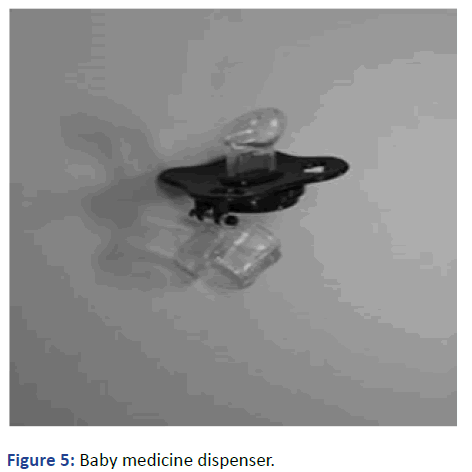
Figure 5: Baby medicine dispenser.
There are also some patents for modified teats and pacifiers
in which the required dose of medication is placed in a
container attached to a hollow nipple. The baby receives the
medication either by sucking the nipple or by the caregiver
compressing the reservoir to get the liquid into the baby's
mouth. An example of a nipple is shown in Figure 6. Both
devices are suitable for newborns and infants, but less so for
older children. Although acceptability may be better, these
devices are generally imprecise, as it is difficult to ensure that
the entire dose has been delivered, and allow only very small
volumes to be delivered.
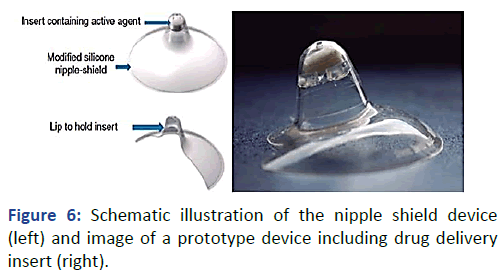
Figure 6: Schematic illustration of the nipple shield device
(left) and image of a prototype device including drug delivery
insert (right).
In addition, the use of milk as a vehicle for drug
administration has also led to the development of the “nipple
shield" delivery system (Figure 7), which contains a
drug loaded insert that delivers the active ingredient into
the milk during breastfeeding of newborns.
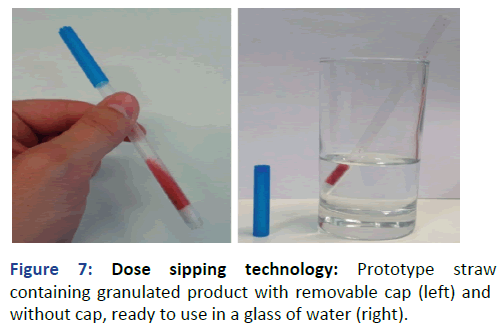
Figure 7: Dose sipping technology: Prototype straw
containing granulated product with removable cap (left) and
without cap, ready to use in a glass of water (right).
Another example of a delivery device is a straw into which a
granular drug has been inserted. By sipping through the straw,
the granules reach the mouth with the liquid. This technique
greatly increases children's compliance.
In addition, "pill swallowing cups" have been developed to
help patients having difficulty in swallowing tablets. Users fill
the cup halfway with a drink, place the lid on the cup and
place the tablet in the spout. The flow of the liquid pushes the
tablet towards the back of the throat allowing it to be
swallowed easily.
Conclusion
Medication habits were different. Self-medication was widely
practiced by many parents using multiple sources of
information. Regarding consumption preferences, syrup was
the most commonly used dosage form and considered by
parents as suitable for pediatric use. The main problems
encountered by parents when administering medicines to
children were related to the organoleptic characteristics of
the drug such as taste, smell, texture, and convenience for
both the parents and the child. Parents often used co-administration
of medication with food or drink. However,
such practices can lead to altered bioavailability and adverse
reactions due, for example, to chemical and physical
instability. Several improvements were proposed by the
parents to improve the acceptability of the drugs, they mainly
concerned palatability, the reduction of the number of intakes
as well as the volume of the liquid oral forms and the size of
the tablets or capsules. As innovative technologies are
expensive, the issue is: how to combine the accessibility of
innovative drugs having a better acceptability with industrial
interests? This is the new challenge for the pharmaceutical
industry in the years to come.
Acknowledgements
The authors would like to thank the parents who participated
in the study.
Declaration of Competing Interest
The authors declare that they have no known competing
financial interests or personal relationships that could have
appeared to influence the work reported in this paper.
References
- Tuleu C (2017) Better medicines for children: Are we there yet? J Pharm Pharmacol. 69(4):349.
[Crossref] [Google Scholar] [PubMed]
- Ivanovska V, Rademaker CMA, van Dijk L, Mantel-Teeuwisse AK (2014) Pediatric drug formulations: A review of challenges and progress. Pediatrics. 134(2):361-372.
[Crossref] [Google Scholar] [PubMed]
- Lajoinie A, Henin E, Kassai B (2015) Choisir la forme pharmaceutique orale la plus adaptée à l'enfant. Arch Pediatr. 22:877-885.
[Crossref] [Google Scholar]
- Chai G, Governale L, McMahon AW, Trinidad JP, Staffa J, et al. (2012) Trends of outpatient prescription drug utilization in US children, 2002-2010. Pediatrics. 130:23-31.
[Crossref] [Google Scholar] [PubMed]
- Venables R, Batchelor H, Hodson J, Stirling H, Marriott J (2015) Determination of formulation factors that affect oral medicines acceptability in a domiciliary paediatric population. Int J Pharm. 480:55-62.
[Crossref] [Google Scholar] [PubMed]
- Montastruc JL, Bondon-Guitton E, Abadie D, Lacroix I, Berreni A, et al. Pharmacovigilance: Risks and adverse effects of self-medication. Therapies. 71:249-255.
[Crossref] [Google Scholar]
- Meyers R (2020) A wish list for drug development in pediatrics. J Pharma Sci. 109:939-943.
[Crossref] [Google Scholar] [PubMed]
- Karunajeewa HA, Kemiki A, Alpers MP, Lorry K, Batty KT, et al. (2003) Safety and therapeutic efficacy of artesunate suppositories for treatment of malaria in children in Papua new guinea. Pediatr Infect Dis J. 22:251-255.
[Crossref] [Google Scholar] [PubMed]
- Schirm E, Tobi H, Vries T, Choonara I, de Jong-van den Berg L (2007) Lack of appropriate formulations of medicines for children in the community. Acta Paediatrica. 92:1486-1489.
[Crossref] [Google Scholar] [PubMed]
- Charkaluk ML, Kalach N, El Kohen R, Kremp O (2005) Family use of ibuprofen in the febrile child: A prospective emergency study in a lillois hospital. Arch Pediatr. 12:1209-1214.
[Crossref] [Google Scholar]
- Di Martino M, Lallo A, Kirchmayer U, Davoli M, Fusco D (2017) Prevalence of antibiotic prescription in pediatric outpatients in Italy: The role of local health districts and primary care physicians in determining variation. A multilevel design for healthcare decision support. BMC Public Health. 17:886.
[Crossref] [Google Scholar] [PubMed]
- Martir J, Flanagan T, Mann J, Fotaki N (2017) Recommended strategies for the oral administration of pediatric medicines with food and drinks in the context of their biopharmaceutical properties: A review. J Pharm Pharmacol. 69:384-397.
[Crossref] [Google Scholar] [PubMed]
- Andrieu V, Reynier JP (2004) La galenique au service de la securite chez lenfant. Therapies. 59:599-601.
[Crossref] [Google Scholar]
- van Riet-Nales DA, Schobben AF, Vromans H, Egberts TC, Rademaker CM (2016) Safe and effective pharmacotherapy in infants and preschool children: Importance of formulation aspects. Arch Dis Child. 101:662-669.
[Crossref] [Google Scholar] [PubMed]
- Kristensen HG (2012) WHO guideline development of pediatric medicines: Points to consider in pharmaceutical development. Int J Pharm. 435:134-135.
[Crossref] [Google Scholar] [PubMed]
- Lopez FL, Ernest TB, Tuleu C, Gul MO (2015) Formulation approaches to pediatric oral drug delivery: Benefits and limitations of current platforms. Expert Opin Drug Deliv. 12:1727-1740.
[Crossref] [Google Scholar] [PubMed]
- Rautamo M, Kvarnstrom K, Siven M, Airaksinen M, Lahdenne P, et al. (2020) A focus group study about oral drug administration practices at hospital wards: Aspects to consider in drug development of age appropriate formulations for children. Pharmaceutics. 12(2):109.
[Crossref] [Google Scholar] [PubMed]
- Mistry P, Batchelor H (2017) Evidence of acceptability of oral pediatric medicines: A review. J Pharm Pharmacol. 69:361-376.
[Crossref]
- Yeung VW, Wong IC (2005) When do children convert from liquid antiretroviral to solid formulations? Pharm World Sci. 27:399-402.
[Crossref] [Google Scholar] [PubMed]
- Rehn C, Odouard E, Poncet F, Cochat P, Breant V, et al. (2018) Factors influencing the acceptability of galeniques formulations in pediatrics-revue de la literature. Ann Pharm Fr. 76:163-171.
[Crossref] [Google Scholar]
Citation: Naoui A, Cherif A, Mhiri A, Kalboussia N, Kacema B (2023) Medicines and Children: Parent Survey. J Pharm Pharm Res.
7:014.
Copyright: © 2023 Cherif A, et al. This is an open-access article distributed under the terms of the Creative Commons Attribution
License, which permits unrestricted use, distribution, and reproduction in any medium, provided the original author and source
are credited.
